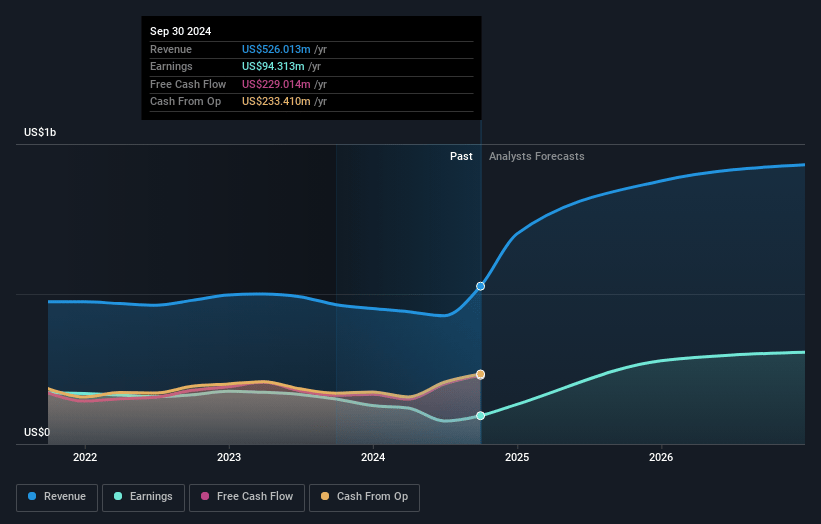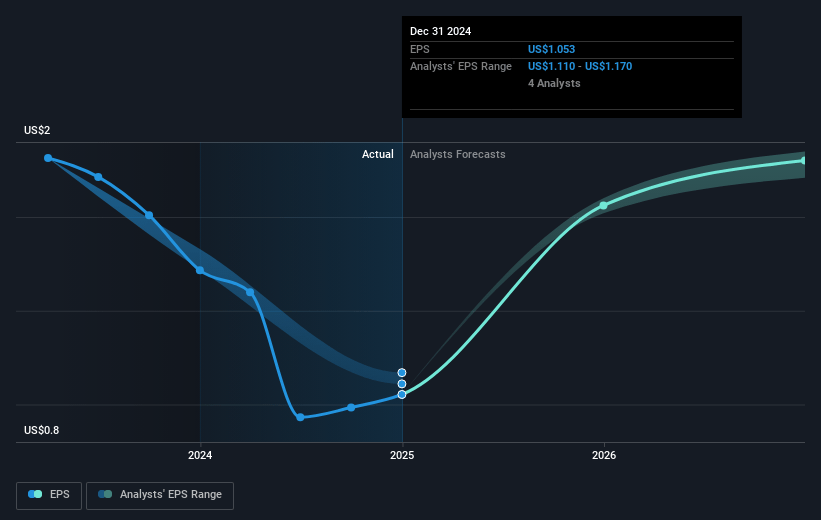Key Takeaways
- Benefits from the Lakeland merger enhance book value, interest margins, and earnings, suggesting robust future revenue growth.
- Expanding into new markets and increased loan production drives organic growth, supported by a strong loan pipeline and credit quality.
- Potential liquidity challenges, credit quality issues, and sensitivity to economic factors could affect Provident Financial Services' revenue stability and earnings.
Catalysts
About Provident Financial Services- Operates as the bank holding company for Provident Bank that provides various banking products and services to individuals, families, and businesses in the United States.
- The realization of benefits from the merger with Lakeland is leading to tangible book value growth, improved net interest margins, and solid earnings, which suggests potential future revenue growth and enhanced earnings.
- The substantial increase in the total loan pipeline to approximately $2.8 billion, with a weighted average interest rate improvement, indicates robust future loan production and potential revenue growth.
- The focus on expanding into new markets, like Pennsylvania and Westchester, and the addition of new teams could drive organic growth and increase revenues in these regions.
- Strong credit quality with low nonperforming loans and net charge-offs provides a stable foundation and could lead to better-than-expected net margins and earnings stability.
- The potential for opportunistic stock buybacks can improve earnings per share, providing another catalyst for improving the company's valuation.
Provident Financial Services Future Earnings and Revenue Growth
Assumptions
How have these above catalysts been quantified?- Analysts are assuming Provident Financial Services's revenue will grow by 18.3% annually over the next 3 years.
- Analysts assume that profit margins will increase from 21.1% today to 43.1% in 3 years time.
- Analysts expect earnings to reach $499.6 million (and earnings per share of $3.7) by about April 2028, up from $147.5 million today. The analysts are largely in agreement about this estimate.
- In order for the above numbers to justify the analysts price target, the company would need to trade at a PE ratio of 8.2x on those 2028 earnings, down from 14.7x today. This future PE is lower than the current PE for the US Banks industry at 11.0x.
- Analysts expect the number of shares outstanding to grow by 7.0% per year for the next 3 years.
- To value all of this in today's terms, we will use a discount rate of 6.91%, as per the Simply Wall St company report.
Provident Financial Services Future Earnings Per Share Growth
Risks
What could happen that would invalidate this narrative?- The decline in total deposits by $175 million, attributed to seasonal outflows, could indicate potential liquidity challenges or difficulty in retaining customer funds, impacting net interest margins and overall revenue stability.
- The increase in nonperforming loans, particularly those two large loans, reflects potential credit quality issues that may lead to higher provisions for loan losses, negatively affecting net earnings.
- The uncertainty surrounding customer reactions to macroeconomic factors like tariffs, even though not immediately impactful, could still lead to reduced investment spending from clients, thereby impacting revenue growth, especially in the commercial lending portfolio.
- The decline of approximately 4% in assets under management at Beacon Trust due to market conditions suggests vulnerability to external economic factors, which could result in decreased fee income and pressure on revenue streams.
- Though the duration of insurance income growth is promising, its seasonal nature can lead to fluctuating noninterest income, potentially causing instability in earnings over different quarters.
Valuation
How have all the factors above been brought together to estimate a fair value?- The analysts have a consensus price target of $20.9 for Provident Financial Services based on their expectations of its future earnings growth, profit margins and other risk factors. However, there is a degree of disagreement amongst analysts, with the most bullish reporting a price target of $22.5, and the most bearish reporting a price target of just $18.0.
- In order for you to agree with the analyst's consensus, you'd need to believe that by 2028, revenues will be $1.2 billion, earnings will come to $499.6 million, and it would be trading on a PE ratio of 8.2x, assuming you use a discount rate of 6.9%.
- Given the current share price of $16.64, the analyst price target of $20.9 is 20.4% higher.
- We always encourage you to reach your own conclusions though. So sense check these analyst numbers against your own assumptions and expectations based on your understanding of the business and what you believe is probable.
How well do narratives help inform your perspective?
Disclaimer
Warren A.I. is a tool utilizing a Large Language Model (LLM) that ingests data on consensus price targets, forecasted revenue and earnings figures, as well as the transcripts of earnings calls to produce qualitative analysis. The narratives produced by Warren A.I. are general in nature and are based solely on analyst data and publicly-available material published by the respective companies. These scenarios are not indicative of the company's future performance and are exploratory in nature. Simply Wall St has no position in the company(s) mentioned. Simply Wall St may provide the securities issuer or related entities with website advertising services for a fee, on an arm's length basis. These relationships have no impact on the way we conduct our business, the content we host, or how our content is served to users. The price targets and estimates used are consensus data, and do not constitute a recommendation to buy or sell any stock, and they do not take account of your objectives, or your financial situation. Note that Warren A.I.'s analysis may not factor in the latest price-sensitive company announcements or qualitative material.




